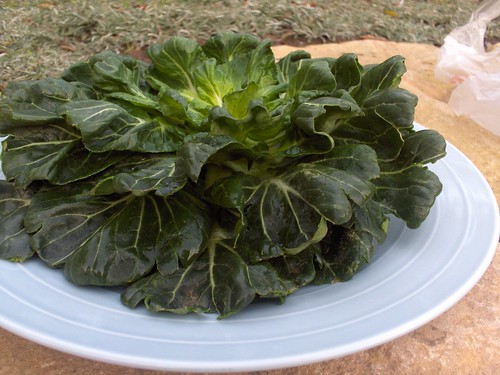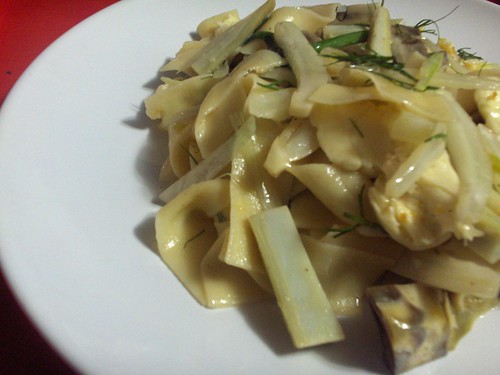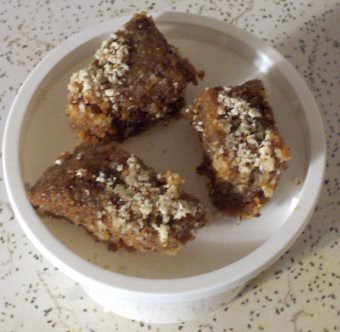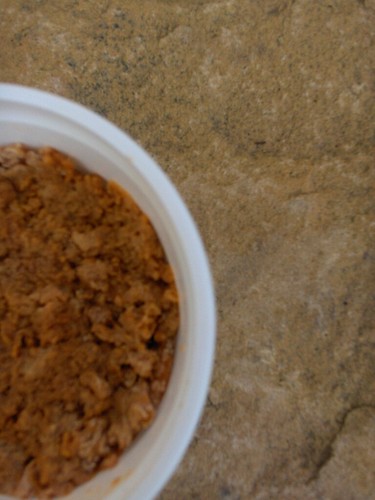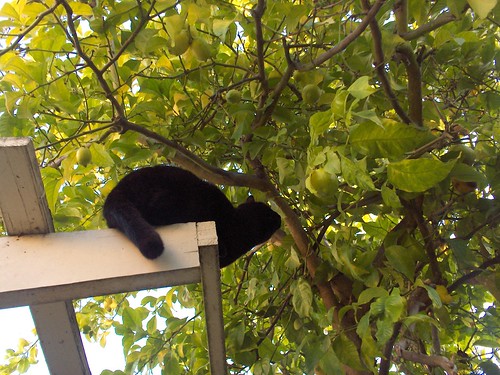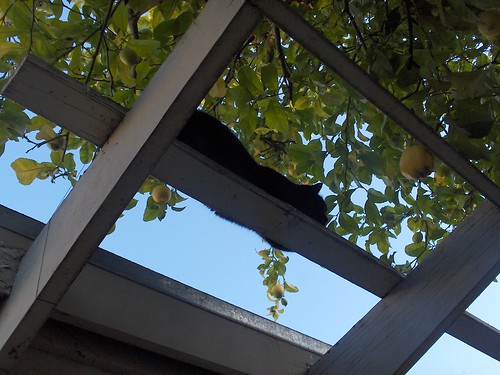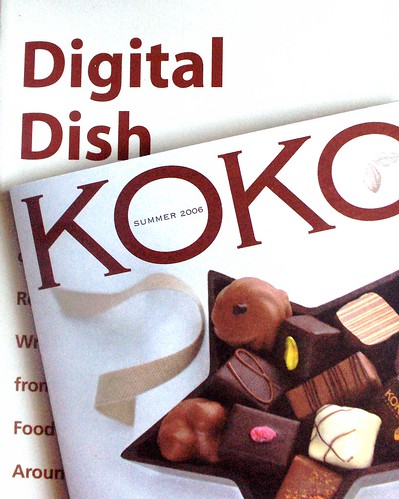There’s been a cold spell out here in California. You can see your breath in the morning, and the cars are covered with a thin layer of frost. Lawns gleam and sparkle with frozen dew, and my dog—who goes into fits of ecstatic anticipation at the sight of a leash—is quite eager to shorten her morning walks. It’s cold, perfect weather for a good stew.
One of my favorite stews is cholent, a traditional Jewish stew cooked very slowly in an oven. Cholent is traditionally eaten as a Sabbath meal as it is well suited to the rules regarding Sabbath food preparation. Religious Jews are prohibited from cooking food on the Sabbath. But food may be kept warm on a pre-existing flame. By starting the cooking process on Friday morning or afternoon, the cholent cooks by sundown—the beginning of the Sabbath. The stew continues to simmer on a very low heat overnight. The oven is not quite hot enough to change the state of the food (the Talmudic definition of “cooking”), but the long, slow heat is enough to build layer upon layer of subtle flavors. Deeply caramelized onions soften into gravy, the meat falls off the bone and infuses the beans and grain with its flavor, while chunks of waxy potato take on an almost smoky flavor.
In the old days, Jewish women would bring their cholent to the village bakery where the pots were kept warm for the Sabbath. On Saturday afternoon, they would gather at the bakery to fetch their pots, bringing home a filling and tasty Sabbath lunch to their families.
Jews the world over made their own style of cholent, with ingedients varying from region to region. Typical ingredients of Eastern European cholent are potatoes, barley, beans, and meat on the bone. (More meat if you could afford it, more bone if you couldn’t.) Sephardi cholent is called hamin, and often includes eggs in their shells. Huevos haminados, as they’re called, turn brown and creamy after a long night of cooking. Iraqi and Kurdish Jews make a version with chicken and rice, called t’bit. North African Jews make a stew called dafeena, with copious amounts of North African spices and often featuring garbanzo beans.
The crown jewel of any cholent is the dumpling or homemade sausage that cooks on top of the stew. The North African dumpling is called kokla, a slightly richer and more savory version of a matzah ball. The Eastern European version is called kishkeh, a sort of poor man’s sausage. Instead of meat, Kishkeh is made of whatever a poor family might have in the larder: an onion, a carrot, some chicken fat, some breadcrumbs or matzah meal. These are grated, mixed, and seasoned simply with salt, pepper, and a little paprika. The mixture is then stuffed into a clean section of beef intestine, or “kishkeh,” loosely translated as gut. When stuffed into the skin of a chicken neck—sewn shut on each end with a needle and thread—this treat is called helzel, or by its typically Yiddish diminuitive, helzeleh.
To the modern, western palate, kishkeh and helzel might sound, well, unpalatable. We’re not used to consuming offal. For many of us, a filet mignon induces an immediate Pavlovian response while the thought of eating intestine triggers a gag reflex. Historically, however, the less desirable parts of the animal were the only parts most folks could afford to eat. This is particularly true for Jewish culinary traditions that feature such delicacies as chopped liver and jellied calf’s foot. And so they should. Ask any Jew of Eastern European descent what they ate at their grandmother’s house, they’ll likely describe bubby’s ethereal chopped liver—neither creamy, nor chunky, and with just the right amount of carmelized onion—on matzah or a slice of warm, toasted challah.
But the beauty of cholent is you don’t have to make yours the way your bubby did. Cholent is infinitely expandable—use garbanzo beans instead of navy beans, steel cut oats instead of barley, osso bucco instead of a large roast. Or try one of the many ethnic varieties of the dish. And leave the window open after dinner.
This post is part of the Waiter, there’s something in my stew! event hosted by Andy of Spitoon extra. Check out Andy’s site for the roundup of stews.
cholent
I used steel cut oats instead of barley. Barley tends to plump nicely and thicken the gravy somewhat. Oats tend to disappear a bit more into the sauce. Millet might work, although I haven’t tried it. I used a combination of new and old world beans, but just about any beans will do. You might want to try using different sizes of beans to achieve a varied texture.
oil for frying
2-3 large veal osso bucco
3-4 potatoes
1 large onion, coarsely chopped
3-4 cloves garlic
1 TBS sweet paprika
1/2 TBS smoked paprika
pepper to taste
1 1/2 c mixed beans, soaked overnight
3/4 c grain, such as barley or oatmeal
4-8 washed raw eggs in their shells
for later:
1 kishkeh (recipe to follow)
1 TBS salt
- Preheat the oven to 200° F (about 93.33° C).
- Heat some oil in a large, heavy frying pan and brown the osso bucco on both sides. Meanwhile, slice a potato into 1/4 to 1/2 inch thick rounds. Use these slices to cover the bottom of your pot. Double up if you still have slices leftover after covering the bottom of the pot.
- Remove the osso bucco from the pot and place on top of the potato slices.
- Add more oil to the pan if necessary, and brown the onions. Season with both paprikas and freshly ground pepper. Press the garlic cloves into the onion mixture and continue frying until the onions are fragrant and have softened.
- While the onions are cooking, coarsely chop the remaining potatoes into large chunks.
- Drain the beans and layer the beans with the onion mixture in the pot. Sprinkle over grains. Add the potatoes and pour over water to cover.
- Carefully nestle the eggs in various nooks and crannies of the uncooked stew.
- Cover and bake in the oven overnight. Before going to bed, check to make sure the stew has enough water. If not, add some hot water, cover, and put back in the oven.
- In the morning, see if the stew needs any more water. Add hot water if necessary. Taste a few beans. If they’ve softened, season the cholent with salt. If they haven’t softened, your beans are too old or you added salt at the beginning of cooking. Start over!
- Place the kishkeh on top of the cholent and continue baking. If the cholent is too liquidy, leave the top off so some of the water can evaporate. Otherwise, cover the cholent.
- After 18 to 24 hours, remove the cholent from the oven. Serve each diner some potatoes, beans, grains, meat, and a chunk of kishkeh. Peel the eggs and serve as an appetizer with challah, chopped liver, and pickles, or eat with the cholent.
Serves 8-10
kishkeh
Rather than buying pre-made frozen kishkeh, you can pretty easily make your own. I love the sweet, salty taste of kishkeh, and the textural contrast between the soft filling and the crisp edges of the sausage.
1 large onion
1 large carrot, or 3 small ones
1 large potato boiled and peeled
1/2 c bread crumbs or matzah meal
1/4 c schmaltz or rendered goose or duck fat
1 TBS salt
1 TBS paprika
freshly ground pepper to taste
2 ft (61 cm) sausage casing
- Grate the onion, carrot, and potato into a medium bowl. Alternatively, process the onion and carrot in a food processor.
- Melt the schmaltz.
- Add the breadcrumbs or matzah meal, the schmaltz, and the spices. Mix to combine.
- Cut the casing in half to make it easier to work with. You’ll end up with two kishkehs, one for now, one you can freeze for later. (You could just as well cook them both.)
- Rinse the casing and tie a knot at one end. Use a sausage funnel, or your fingers, to stuff the casing. (This is a bit messy, but it works.)
- Use your thumb and forefinger to find the opening of the casing. Insert one finger into the opening, then another. Pull your fingers apart slightly, forming an upside down peace sign. Use this space to force stuffing down the casing with your other hand. When you’ve got a lump of stuffing in the casing, carefully push it down towards the knotted end by wrapping your hand around the tube. If air bubbles form, push the stuffing up a bit to let the air out, then back down.
- Continue stuffing the casing and letting out air bubbles. Stop when you have an inch or two of empty casing left. Let out any last air bubbles and knot the casing tightly.
- Repeat with the other casing.
- To cook kishkeh, do any one of the following:
- Poke holes in the casing and fry.
- Poke holes in the casing and fry. Slice into rounds and fry until crisp on both sides.
- Poke holes in the casing. Cook on top of cholent.
Makes 2 kishkehs

